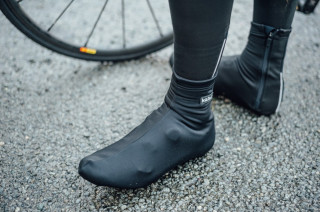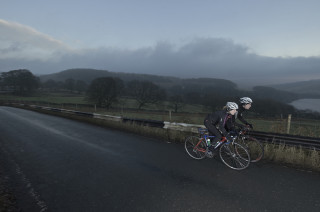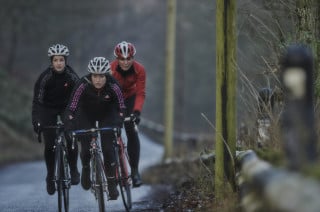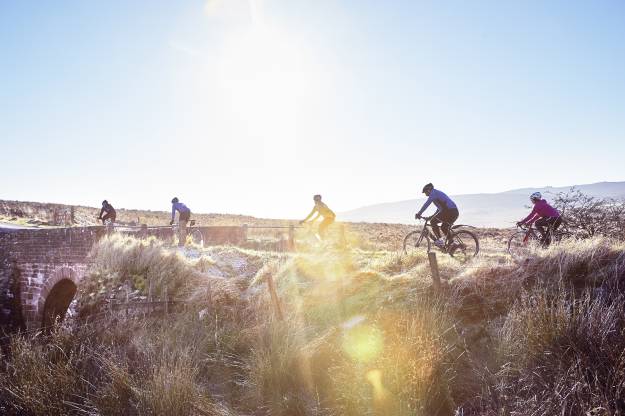Knowledge Level: Intermediate

Frozen feet can turn any ride into a miserable slog. Your feet get cold because, when your core temperature drops, your body diverts warming blood flow away from your extremities. Stiff soled cycling shoes attached to metal pedals act as heat sinks, effectively draining warmth from your feet. They’re also right in the firing line for spray off the road and, spinning around at a constant 90 RPM, are constantly generating their own wind chill effect.
Overshoes or booties
Heavy duty, insulated and waterproof overshoes are your primary weapon against frozen feet. They come in a range of materials and designs but the most important thing is that they fit well with minimal gaps and openings. Look for models which cover a decent proportion of the sole of your shoe, with just a gap for the heel and cleat.
Booties are effectively shoes and overshoes combined in one winter ready package. If you’re going to be putting in significant winter miles these can definitely make more sense than trying to winter proof your summer shoes.
Mudguards
If you can stop your feet getting wet, half the battle against cold feet is won. Full mudguards make a massive difference to all round, as well as foot, comfort in the winter and your ride mates will thank you too.
Warm before you ride
You can at least start the ride with toasty feet by putting your socks and shoes on the radiator to heat up before you head off. If you’re riding on consecutive days, do everything you can to ensure your shoes are fully dry before you next head out.

Choose your socks wisely
Don’t go for the thickest wooliest sock you can find as this may end up constricting your feet. Merino offers great insulation for its weight, wicks superbly and even continues to insulate when wet. Waterproof socks are another option and, if your shoes allow, thin liner socks give another layer of warmth. Socks that come well up your calves or even up to your knees are a good idea. Your calves are not especially active when cycling and can easily become chilled and any sort of gap around your ankles will chill you rapidly.
Check for vents
With summer riding in mind, manufacturers design cycling shoes out with multiple vents and drainage holes. If you’re using summer shoes under overshoes, spend some time with some tape covering up the vents and drainage holes.
Tights over the top
Make sure that the bottoms of your tights or leg warmers come over the top of your overshoes or booties; designs with ankle zippers make this far easier. This will stop, or at least delay, water getting in and soaking your feet.
Bike fit
If you suffer from numb feet or hot spots during the summer, this can easily translate to cold feet in the winter. Checking your bike fit and particularly looking at your cleat position or pedal type can often solve foot problems.
How to fit your cycling cleats (video)

Loosen your shoes
If your shoes and socks combo is too tight, it’ll restrict blood flow and your feet will chill faster. Loosen your shoes off a bit or, if you’re buying shoes or booties especially for winter riding, opt for a size or two bigger.
Foot warmers
Disposable chemical foot warmers have an adhesive surface to keep them in place in your shoes and typically give 4-5 hours worth of gentle warmth. They’re available for outdoors retailers but, costing about £2 per pair, if you’re riding regularly the cost will soon add up. That said, if you really suffer from cold feet, for long rides they’re definitely worth a try.
A couple of manufacturers have attempted to develop electrically heated insoles but, although this technology is used fairly extensively by motor cyclists and winter sports enthusiasts, it’s never really taken off for cyclists. You can definitely find insole systems that could be used for cycling though and, if frozen feet are stopping you riding and you’ve tried everything else, do a bit of online research.
Keep your core warm
Although you don’t want to overdress, an extra vest, slightly thicker jersey or a decent hat under your helmet can help prevent your body from restricting blood flow to your hands and feet. Part of keeping your core warm is remembering to fuel and hydrate correctly. Try using an insulated bottle with a hot drink in. Tea with honey works really well.
Free Nutrition Guide eBook















